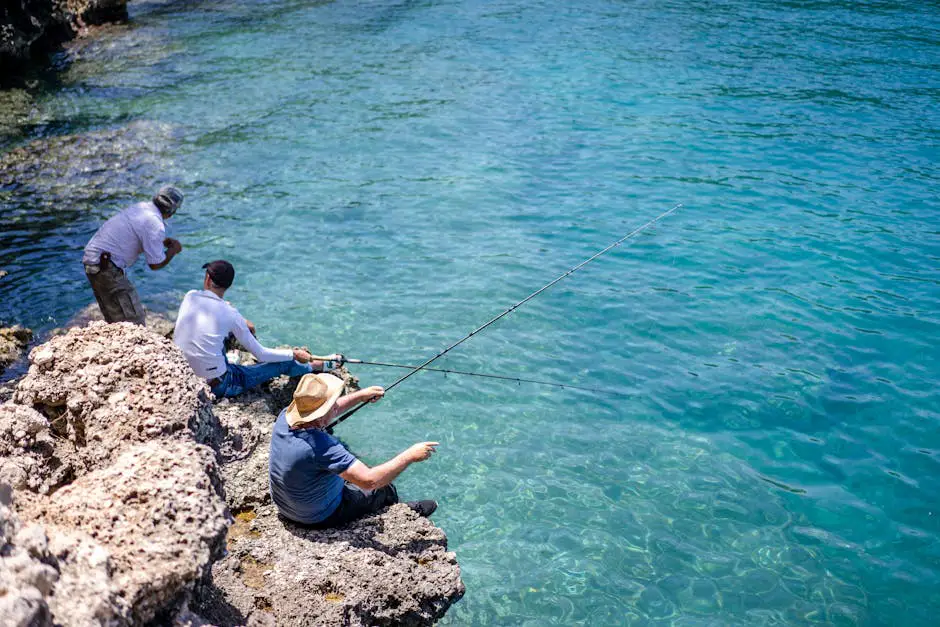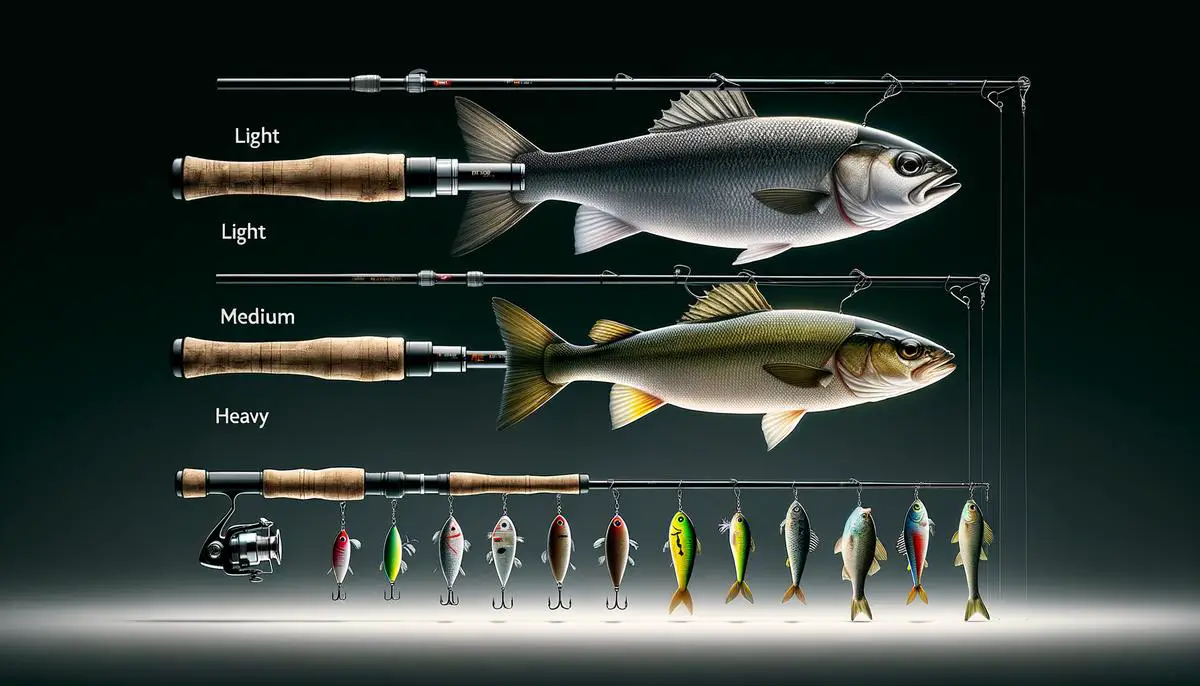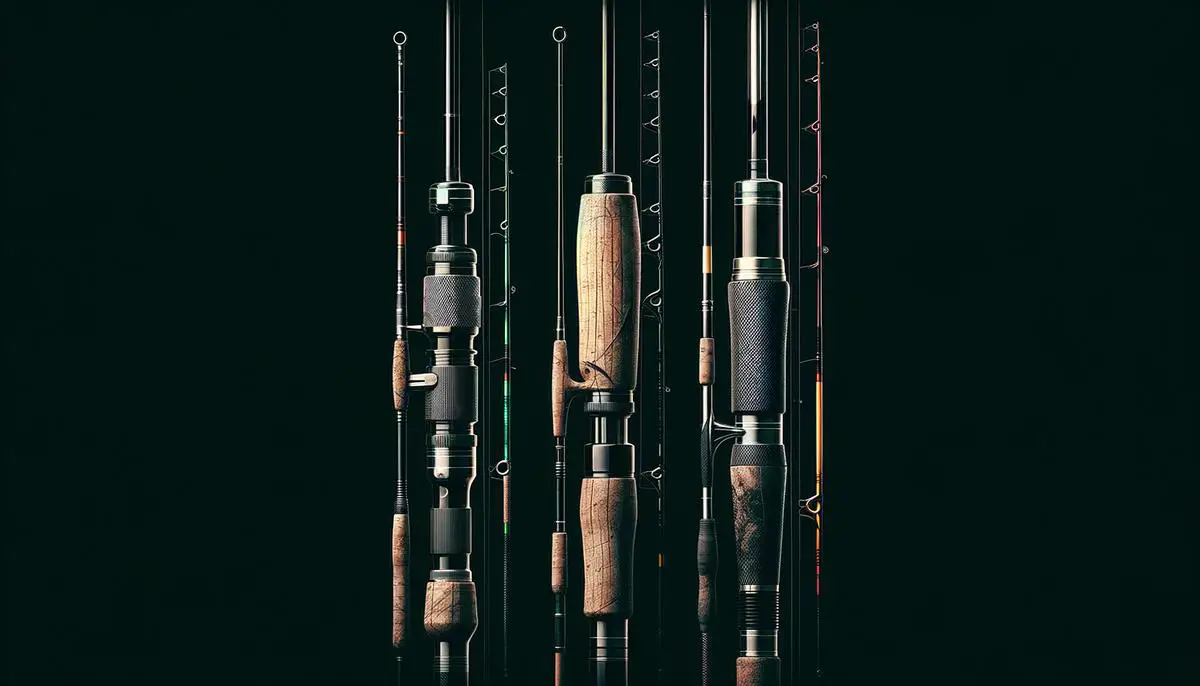Understanding Rod Action
Rod action is a crucial aspect of picking out your trusty fishing pole. It's all about where your rod bends when you apply pressure. Think of it like a scale ranging from extra fast to slow.
Extra Fast Action
These rods bend right near the tip. If you're all about feeling every twitch on your line, extra fast action is the way to go. They're super sensitive, making it easier to detect even the lightest nibbles. Perfect for finesse fishing, where quick hook sets are key.
Fast Action
Fast action rods offer a nice mix. They bend in the upper third of the rod. This makes them versatile—sensitive enough for light bites, but sturdy enough to handle some bigger fish. They're great if you're tossing baits and want a good balance between responsiveness and casting power.
Moderate Action
Moderate action rods bend around the middle. These are your go-to for casting bigger baits without sacrificing too much sensitivity. They're not as fast on the hook set, but their strength and flexibility make them a solid choice for a variety of fishing scenarios.
Slow Action
Slow action rods arch from the lower third all the way down to the handle. They're great for casting long distances. Ideal if you're working with larger baits like swimbaits, the rod's bend absorbs the force of the cast, preventing any snap. However, they do require you to pull back further when setting the hook.
Having these different actions at your disposal ensures you're ready for any fishing adventure. Whether you're finessing for a light bite or casting hefty lures, there's a rod action that fits the bill.
Determining Rod Length
The right rod length can significantly level up your fishing game. Rod length directly impacts casting distance and control, so picking the right one is essential for your specific fishing adventures.
Shorter rods, typically ranging from 5 to 6 feet, excel in delivering precision. These compact warriors are perfect when you need to cast with pinpoint accuracy, such as around docks, rivers, or small streams. They're nimble and allow you to maneuver easily in tighter spots, making them ideal for fishing in areas cluttered with obstacles.
On the other hand, longer rods, stretching from 8 to 10 feet, are your go-to for covering more water. If you find yourself out in the open, whether it's a big lake or along the surf, these rods let you cast your line further out, reaching those distant fish without needing a boat. They come into their own when you need to cover expansive areas and need that extra casting range to get your lure where it needs to be.
Think about your typical fishing scenarios: are you more likely to be threading the needle in a confined space, or launching your bait across wide-open waters? Your choice of rod length should reflect your fishing environment.

Choosing Rod Power
Rod power measures the rod's strength and ability to handle different fish sizes, and it's generally labeled from ultra-light to extra heavy.
Light power rods are the finesse-dancer of fishing. They're delicate, sensitive, and perfect for light lines and small baits, making them ideal for trout fishing or panfish. They allow you to feel subtle nibbles that heavier rods might miss, giving you the upper hand in catching those elusive smaller fish.
On the flip side, if you're hunting for big game fish, you'll need a rod with some serious muscle. Heavy power rods are built for the task, enabling you to confidently cast larger baits and tackle hefty fish like pike, musky, or even some saltwater species. These rods give you the backbone to pull the big ones out of heavy cover and open water alike.
For most anglers, the sweet spot lies in a medium power rod. These are the jack-of-all-trades in the fishing world. Versatile and adaptable, medium power rods can handle a variety of fishing scenarios, from freshwater bass fishing to inshore saltwater adventures. They strike a fine balance between sensitivity and strength, making them great for general use.
Your choice of rod power should match your targeted fish size and fishing method. If you're going after smaller species with finesse techniques, light power rods are your best bet. Conversely, if your adventure involves battling larger, stronger fish, then stepping up to heavier power rods is a wise move.

Selecting the Right Rod Material
When you're starting out as an angler, simplicity and durability are your best friends. Enter fiberglass rods. These trusty companions have been around for ages and are renowned for their toughness and flexibility. They can take a beating, making them the ideal choice for newbies who are likely to be a bit rough on their gear. Plus, they're more affordable.1 Picture yourself battling a feisty fish, the rod bending beautifully under the pressure without fear of it snapping. That's fiberglass for you – strong, resilient, and perfect for those just cutting their fishing teeth.
But suppose you're looking for something that offers a bit more finesse. In that case, it's time to consider graphite rods. These bad boys are the featherweights of the fishing world – incredibly light and super sensitive.2 Imagine feeling the tiniest nibble on your line, almost like an electric current traveling straight to your fingertips. That's the magic of graphite. They allow you to detect even the slightest fishy interest, making them perfect for finesse fishing. However, there is a catch (pun intended): graphite rods are more brittle. While their sensitivity is unmatched, they can break if pushed beyond their limits. So, if you're handling big game fish or fishing in rough terrain, you might want to tread lightly with these beauties.
And then, there's the best of both worlds – composite rods. These hybrid rods blend the strength and durability of fiberglass with the sensitivity and lightness of graphite. It's like having your fishing cake and eating it too. Composite rods are remarkably versatile. Whether you're into freshwater fishing, saltwater excursions, or anything in between, composite rods have got you covered.3 They offer a balanced performance, making them adaptable to a variety of fishing scenarios. But this versatility does come at a price, quite literally. Composite rods are usually more expensive, but many anglers find that the boost in performance and adaptability is well worth the extra bucks.
When choosing your rod material, think about your fishing style and the conditions you most frequently fish in. If you're just starting out and need something durable, go for fiberglass. If you're after sensitivity and lightness, graphite is your rod of choice. And if you want versatility and can stretch your budget a bit, composite rods are your go-to.

Understanding Rod Markings
Rod markings reveal everything you need to know: length, action type, and recommended line and lure weights. It's like having a built-in instruction manual for picking the perfect rod.
First up, rod length. This is usually the first set of numbers you'll see. For example, a marking of "7'3" indicates a seven-foot, three-inch rod. Length is important because it influences both your casting distance and control. Shorter rods (around 5 to 6 feet) offer precision and power for fighting fish at close quarters. Longer rods (stretching up to 14 feet) launch your bait farther into open waters. Find your sweet spot based on your typical fishing environment and target species.
Next, let's tackle action type. This might be listed as "F" for Fast, "MF" for Medium Fast, and so on. Rod action determines where and how much your rod bends under pressure. Fast action rods (bending near the tip) are great for sensitivity and quick hook sets, while slow action rods (bending down to the handle) provide the casting distance for those larger, playful fish.
Now, let's hash out power and recommended line and lure weights. These are often marked somewhere along the blank like "Line Wt 8-12 lb, Lure Wt 1/4 – 1/2 oz." This notation tells you the rod's muscle—how much pressure it can withstand, and the recommended weights for lines and lures. Lightweight rods offer the finesse for delicate presentations, making them perfect for smaller species like crappie or bream. Heavy-duty rods, on the other hand, give you the leverage to cast heftier lures and battle bigger game like catfish or even saltwater giants.
Rod markings empower you with a treasure trove of information, turning the daunting task of selecting a fishing pole into a well-directed adventure. Trust these tiny indicators—they're your roadmap to the perfect fishing rod.
Exploring Different Rod Handles and Guides
Handles and guides are important parts of a fishing rod that can impact your comfort and performance on the water.
Handles come in two prevalent materials: cork and EVA foam. Each has its unique benefits, so finding the right one boils down to your personal preference and fishing routine.
Cork handles are soft, warm, and incredibly sensitive, offering unparalleled comfort, especially on those chilly early mornings. This heightened sensitivity means you can feel every little nibble, transfer vibrations directly to your hand, almost like having a direct line of communication with the fish. However, cork is less durable. It tends to wear out faster, developing dents and becoming harder to clean over time, particularly if you're one to plant your rod into rocky terrains or rod holders.
On the flip side, EVA foam handles are tough, long-lasting, and incredibly easy to clean.4 EVA foam handles make great companions for anglers who venture into rougher environments or those who simply don't have time to baby their gear. While it may not offer the same level of sensitivity as cork, EVA foam provides a solid, dependable grip, standing the test of time against the elements.
Beyond material, handle shape matters as well. The short, contoured pistol grip, complete with a hook for your index finger, is excellent for casting accuracy and precise jigging movements. Alternatively, the longer, dual-handed trigger stick allows for greater leverage and casting distance, perfect when you need that extra muscle to reel in the big fighters.
Next, let's shed some light on rod guides—those little rings lining up along your rod. They might not look like much, but they are crucial in ensuring smooth casts and fights. Most modern rods feature metal guides with a ceramic coating inside. Ceramic reduces friction on your line, allowing it to slide through smoothly, giving you greater casting distance and accuracy.
The number of guides on your rod also plays a significant role. More guides help evenly distribute the stress across the rod, ensuring that your line remains intact and your rod doesn't break under pressure.5 While having more guides might increase the cost slightly, this added precision and durability often prove to be well worth the investment.
So, as you gear up for your next fishing adventure, pay close attention to handles and guides. Choose the handle that fits your style—be it the luxurious sensitivity of cork or the durable comfort of EVA foam. And don't overlook the guides—opt for quality, ceramic-coated ones with enough numbers to keep your line running smoothly. These seemingly small details go a long way in enhancing your overall fishing experience, ensuring every cast, tug, and haul feels just right.

So, next time you're picking out a fishing rod, remember: it's all about matching the right tool to your style and needs. Whether it's the action, length, power, material, or even the handle and guides—each element plays a crucial role in making your fishing experience enjoyable and successful. Happy fishing!
- Morley S, Armstrong J, Ball S. The effect of rod material on the performance of anglers using single-handed fly rods. Fish Res. 2001;51(2-3):257-264.
- Riyanto M, Yuniar T, Wisudo SH, Purbayanto A. Fishing rod construction for fishing rod-driven fisheries. IOP Conf Ser Earth Environ Sci. 2019;241:012025.
- Baumgartner L, Cameron L, Stanger M. Effects of different rod and reel types on juvenile mulloway (Argyrosomus japonicus) catch rates. Mar Freshwater Res. 2007;58(8):758-761.
- Rajeswari G, Sanjeev Kumar M, Santhosh B. Fishing rod vibration with EVA grip. Appl Mech Mater. 2015;772:120-124.
- Gatti P, Sala R, Gori M, Grigolato S, Cavalli R. Rod guides stress distribution on a fishing rod blank under quasi-static load. Eng Fail Anal. 2020;118:104927.



Welcome to our blog!